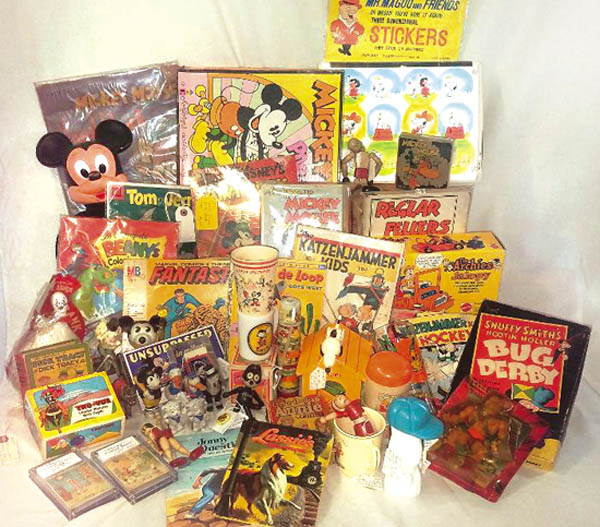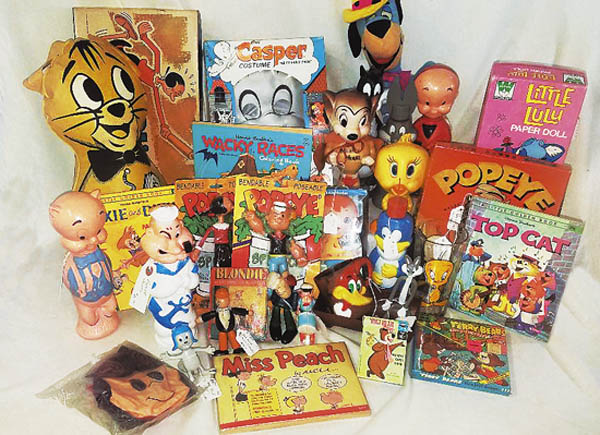Comic Friends To Appear At The Burlington Emporium
By Bob Weidner - January 01, 1970
For most baby boomers and their parents, comic and cartoon characters were a beloved part of youth. This is particularly true of those appearing in various media on weekends. Who doesnt cherish the memories of Saturday mornings in the 1950s and 60s watching TV kiddies shows featuring our animated friends. For most of our parents, growing up before television included a weekly trip to the local cinema for the Saturday childrens matinee. Sundays held the pleasure of finding the colorful funnies from the bulky morning newspaper and spreading it out on the floor or kitchen table to read the latest adventures of our favorite comic heroes. Sunday Funnies provided longer versions (as much as a full page) of the one-line comic strips offered in black and white in the daily papers. They were in bright colors and contained in a separate supplement, easily found and removed from the more mundane sections of news. Color strips first appeared in the Sunday paper in the late 19th century and included such groundbreakers such as The Yellow Kid and Buster Brown. Over time, the subject matters of strips ran the gamut from adventure, detective and humor to drama, either as a continuous ongoing story (Steve Canyon, Flash Gordon, Prince Valiant, Dondi, The Phantom, Little Orphan Annie, Terry and the Pirates) or as a single-episode gag (Mutt and Jeff, Little Iodine, Little Lulu, Peanuts, Hagar the Horrible, Pogo, Lil Abner, Blondie and Dagwood, Nancy and Sluggo, Smokey Stover, Gasoline Alley, Snuffy Smith, Dennis the Menace, Bringing Up Father, Calvin and Hobbes). During their heyday, beginning with the Depression in the late 1920s up to the 1960s, movies were one of the most popular recreational activities, especially for children. They flocked to the neighborhood theaters for a targeted program of movies, serials and animated cartoons. After a package of cartoons (such as Disney (Mickey Mouse and friends), Warner Bros. (Bugs Bunny, Road Runner, Porky Pig), Terrytoons (Mighty Mouse, Heckle and Jeckle, Gandy Goose, Dinky Duck), MGM (Tom and Jerry), Walter Lantz (Woody Woodpecker, Andy Panda, Gabby Gator), and others (Popeye, Looney Tunes) came the latest chapter of an adventure serial followed by the main movie, often a double feature. This full program was inexpensive and offered hours of unsupervised rowdy fun including childrens clubs and door prizes. Following the demise of the Saturday Matinee with its theater-based cartoons in the 1950s, Saturday Morning childrens programming consisted of, in part, these older cartoons previously broadcast on after-school TV. Later, others were reruns of now classic 1960s cartoons originally made for prime-time family viewing, for example, Beany and Cecil, Johnny Quest, The Jetsons, The Flintstones, and Top Cat. The Mid-60s brought a flood of new superhero cartoons including Spider-man, Fantastic Four, Superman, Aquaman, Space Ghost, He-Man and Masters of the Universe, George of the Jungle, and Underdog. This period also included music-related cartoons such as The Beatles, Josie and the Pussie Cats and The Archies, as well as mysteries (Scooby Doo, Jabberjaw, Speed Buggy), monsters (Casper the Friendly Ghost, Melvin the Monster, The Groovie Goolies, The Gruesomes, The Addams Family, Fankenstein, Jr.), and others (Wacky Races, Hector Heathcote, Linus the Lionhearted, Hoppity Hooper). The 70s brought a rash of animated versions of popular real action prime time shows and other characters. Examples include The Dukes (of Hazzard, The New Adventures of Gilligan, Star Trek: The Animated Series, Lassies Rescue Rangers, The Brady (Bunch) Kids, Fat Albert and the (Bill) Cosby Kids, Partridge Family 2200 A.D., (Return to) Planet of the Apes, Godzilla, The Harlem Globetrotters). Sadly, by the end of the decade, public pressure on government and the television industry relating to children-targeted advertising and cartoon content, the era of purely fun-filled Saturday mornings came to an end, replaced with educational and enrichment programming. Beginning with The Yellow Kid and Buster Brown, a myriad of popular characters that filled our childhoods from our weekend entertainment options were used by sponsors as subjects for advertising premiums as well as toys and other retail merchandise portraying them. The variety and number of cartoon and comic character collectibles are virtually limitless, providing a wonderful subject matter for collecting for children of all ages. In April, the Emporiums special sales case will provide a sampling of these collectibles that were enjoyed during the years from 1900 to 1980. All are invited to enjoy a day of shopping at the Emporium to take in the memories that this sales display will invoke. The Emporium is a 14,000-square-foot historic building housing more than 65 dealers of quality antiques and collectibles, located at 424 High St., Burlington, N.J. It is open seven days per week from 11 a.m. to 5 p.m., with extended hours to 7 p.m. on Thursdays. For more information, call 609-747-8333. Until then, well see you in the funny papers.



SHARE
PRINT